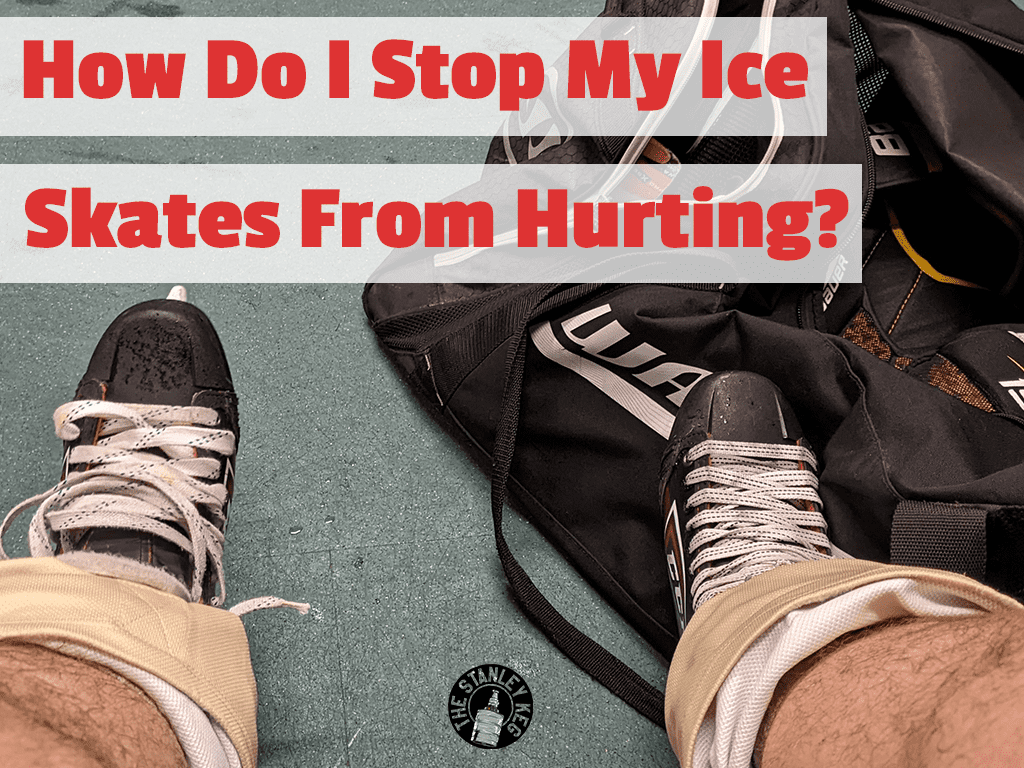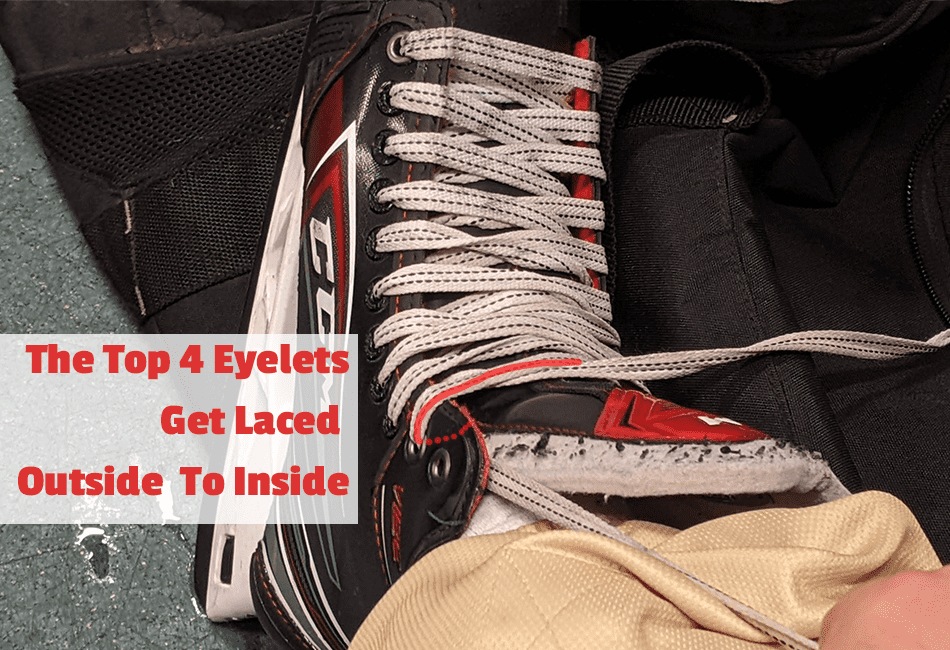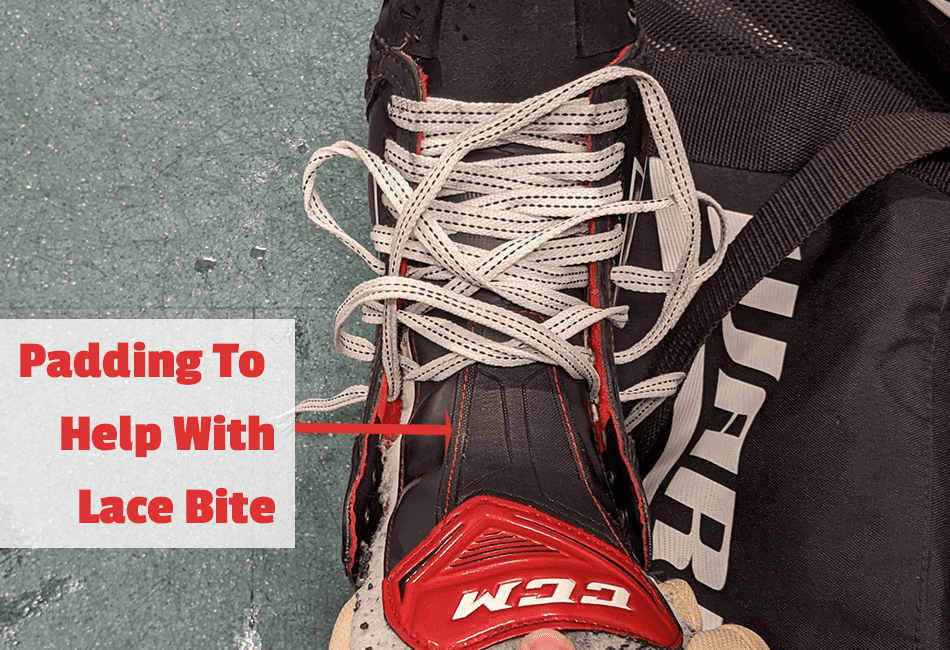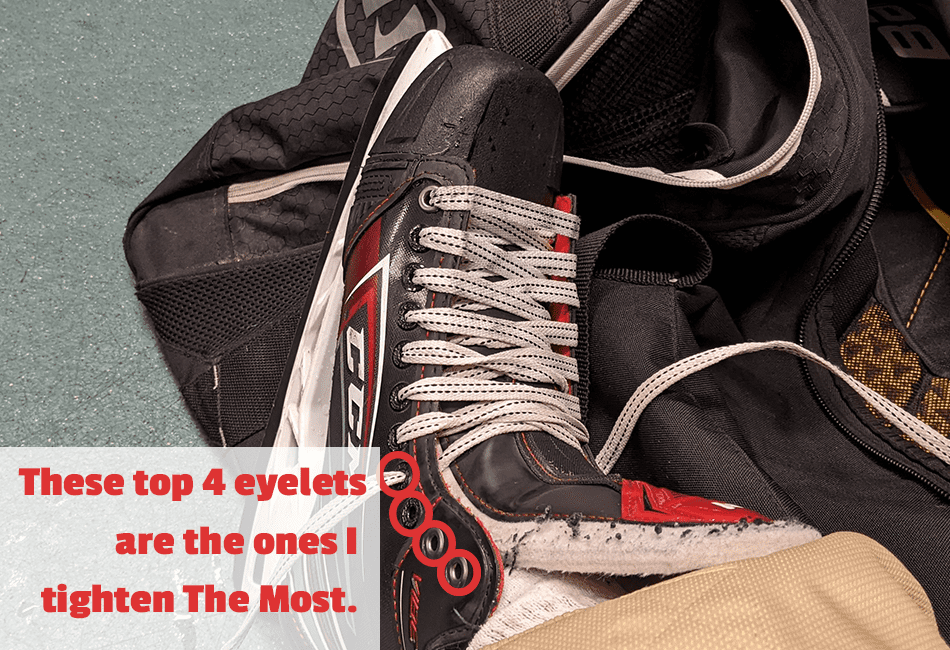
If you are here your hockey skates are probably hurting your feet
The best way to make sure your hockey skates don’t hurt your feet is by buying the appropriate-sized skates, baking them to your feet, Supporting your arches, and lacing your skates appropriately. Most hockey skate discomfort will come from lace bite or poor fitting skates causing pressure points on your feet.
Read on and we will talk about some simple ways that I have been able to alleviate my feet pain while playing hockey.
How To Avoid Lace Bite With Hockey Skates
Lace bite is a term for when you have a sharp pain in the top of your foot and ankle. Your ankle may be painful to the touch, it may be red and swollen and it may be difficult to skate through in extreme cases. Lace bit is usually caused by:
- Tying your skates too tight
- Not skating for a while and going balls to the wall
- Having poor-fitting skates
- Wearing brand new skates
The most simple way to try to avoid lace bite is to make sure that you are tying your skates correctly. When I first started skating I just wanted my skates as tight as possible EVERYWHERE. Come to find out, this can cause some serious pain
I have found a lot of personal relief from pain by tying my skates in a different way. I now leave the foot portion of my skates just snug. I don’t actually start pulling my laces really tight until I have about 4 eyelets left. I have also started looping my laces from the outside coming in on my top few eyelets. I have found that this applies pressure to the outside of the boot more so than my ankle/foot area. This still provides plenty of support but has alleviated some pressure.

Some of the other causes of lace bite are having brand new skates and just having to break them in. You can always try baking your skates, which molds them to your feet to expedite this process but sometimes there is no way around breaking skates in besides just suffering for a few times on the ice.

How To Bake Hockey Skates To Your Feet
What does it actually mean to bake your hockey skates? It simply means heating up your skates to a point where the material becomes slightly moldable and putting them on to your feet so that they can begin to actually form to your foot. On most skates, only some portions are able to be heat molded but on other more expensive skates, like the CCM Jetspeed FT4, the whole skate is heat moldable.
So with the more expensive skates, you are going to notice the biggest benefit from heat molding, or baking your hockey skates.
Lots of local pro shops offer this service for you but you can also do it at home.
When you bake your skates it’s best to get your whole skate warm. This means the boot, the blade, the laces, should be at 200F when you take it out of the oven.
You will want to get the skates on your feet fairly quickly so they don’t cool down too much.
At this point, the skates are pretty vulnerable to damage, especially around the eyelets so it is crucial to be careful when lacing these puppies up to your feet. You always want to pull OUT when tightening your skates. Never pull up and cause pressure on your eyelets. After the skates have been fully laced, you will want to remain seated for about 10 minutes. Avoid walking around, putting curves in your boot, and pressure on the eyelets of the skate.
After they have cooled on your feet for 10 minutes or so you are free to take them off and you should have a hockey skate that has conformed to your foot.
If these are brand new skates, and you have skated with them say 4 or 5 times and you are still feeling pain and discomfort, I would recommend taking them back to the pro shop to see if there is anything they can do to help you out. They may be able to heat spot a portion of your skates or punch them out. Meaning they can target specific spots that may be applying pressure to your foot.
How To Choose The Right Sized hockey Skates For Your Feet
Your shoe size does not match your hockey skate size. A general rule is that your hockey skate size is 1.5 sizes smaller than your shoe size. This method works most of the time but the best way to determine your skate size is to go to your local pro shop and try a few pairs of skates on.
| US Shoe Size | Skate Size |
| 8.5 | 7 |
| 9 | 7.5 |
| 9.5 | 8 |
| 10 | 8.5 |
| 10.5 | 9 |
| 11 | 9.5 |
| 11.5 | 10 |
| 12 | 10.5 |
| 12.5 | 11 |
| 13 | 11.5 |
There is more to a hockey skate than just your standard size. There is also a width factor you should take into account.
| Skate Width | Skate Fit |
| C | Narrow Feet |
| D | Average Width |
| R | Slightly Wider Than Average |
| E | Wide Feet |
| EE | Really Wide Puppies |
Like I said previously, this is just a general rule. The absolute best way to figure out your skate size is to go to your local rink and try a few pairs on. I wear a size 11 – 11.5 depending on the shoe and my skates (which are CCM Jetspeed Vibes) are a size 9 D. My rink had this really awesome machine that actually measured your foot, pressure points and arches to give you a great recommendation.
It also helps when you have a great staff in your pro shop. The guys at my shop told me that my skates should be basically touching my toes when sitting, but when I stand my foot should slide back in my boot just barely so that my toes come off of the front.
Since following this advice I feel like my skating has gotten better and my feet hurt less.
How To Stop Arch Pain When Ice Skating
Arch pain when skating with hockey skates can be caused by improperly fitted skates, laces that are too tight or the incorrect kind of support. It is also very common to have arch support in fresh skates. There is a period of time that will need to pass in order for you to break your skates in. If you have baked your skates you can shorten that time but there will still be pain for the first couple of skate sessions.
However, if you are still feeling pain after 10+ skating sessions you should do something to address this. The first most common reason for arch pain is improperly fitted skates. Reference the above section in this article about properly fitted skates.

One of the more common, yet easily fixable, issues that cause arch pain is the way you lace your skates up. Lots of players have said that they leave the laces towards the bottom of their boot fairly loose. Especially the laces that cross right over the top of your foot. This includes me, I don’t really start to tighten my skates super tight until I get to the ankle area on my skates. This method of tying your skates avoids unnecessary pressure around the arch of your foot but still keeps your skates snug where it matters.
Depending on the shape of your feet (Flat or super arched) Insoles might be a good idea. Lots of people have said good things about the brand superfeet. They aren’t a brand that is known for hockey exclusively but they definitely know how to make a good insole. If I was having arch pain I would try that brand over any other brand based on all the good reviews. Bauer and CCM also make their own insoles. They are a bit cheaper than the Superfeet brand but From what I have read and heard, right now you can’t beat the Superfeet.
How To Make Hockey Skates More Comfortable
Brand new hockey skates can be uncomfortable at first. You need to break them in and get them molded to your feet.
To make hockey skates more comfortable you first need to make sure you have the right-sized skates in both length and width. Secondly, you should avoid lace bite and arch pain by appropriately lacing your skates and offering your feet the support they need through insoles. Finally, if you have a mid-tier skate and above you should be baking them so that they can mold to your foot.
If you do all of these things your skates should fit your foot like a glove and provide you with support and comfort while on the ice.
There is a break-in period no matter what. Keep in mind, that new skates are going to hurt at first but that shouldn’t last forever. If your hockey skates continue to hurt you after following all of this advice I would suggest talking to the guys at your pro shop to see if they can help you out at all.
